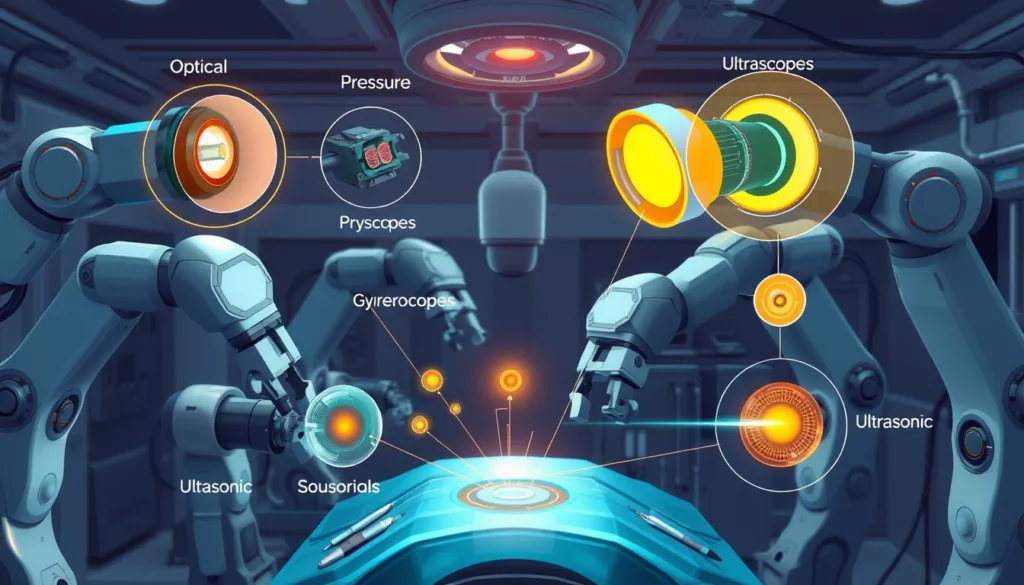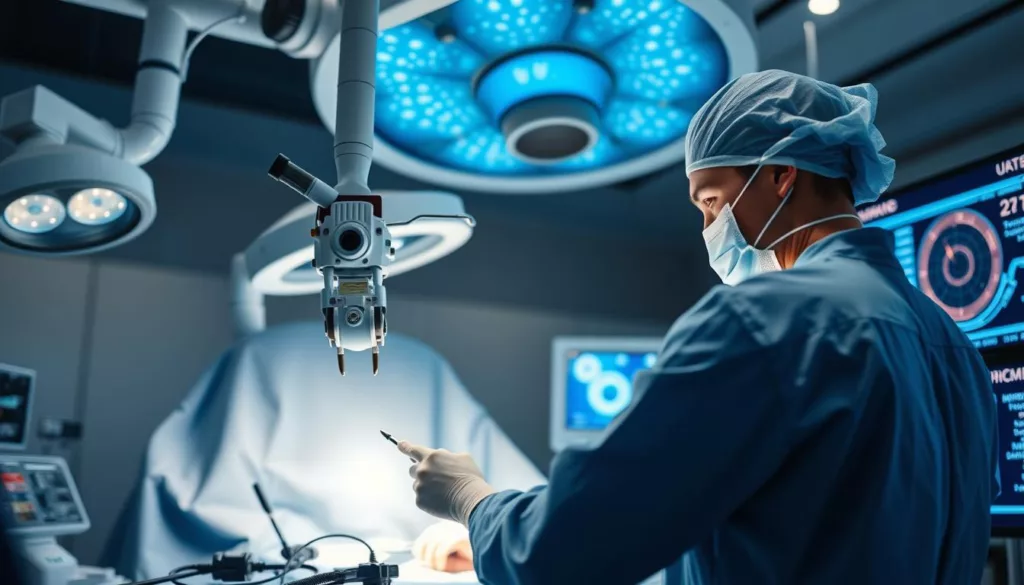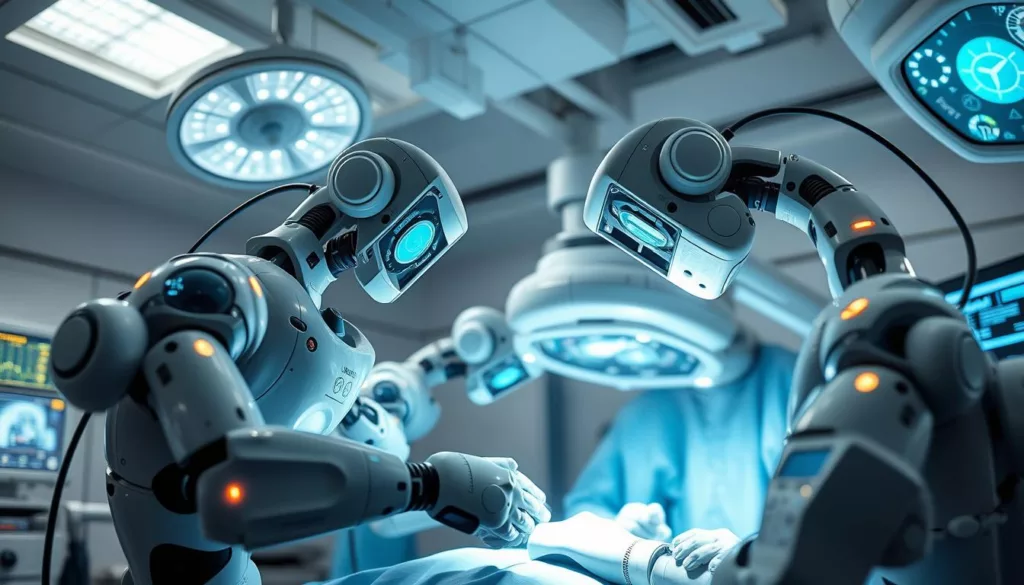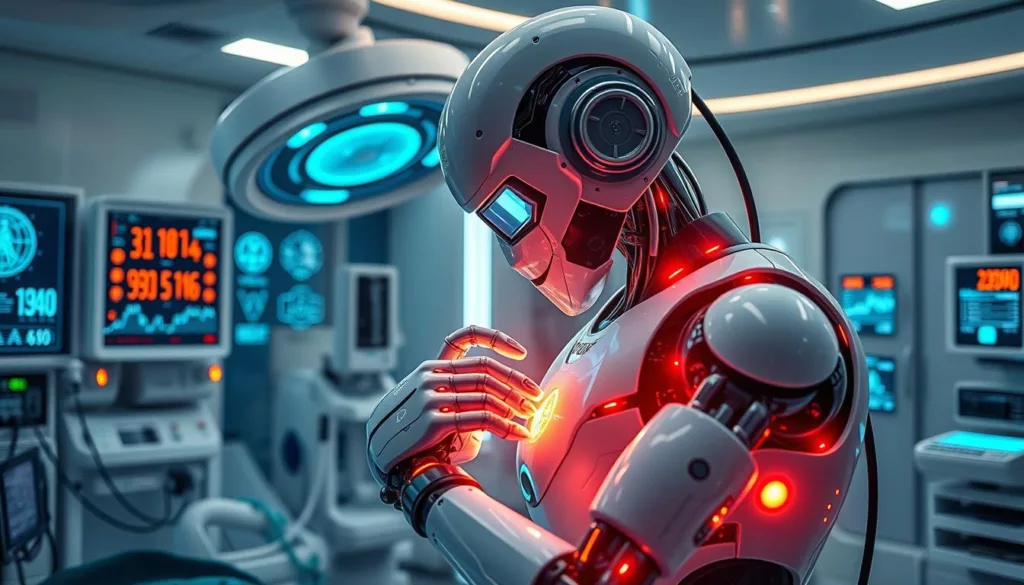The world of medical robotics is changing fast, thanks to sensor technology. Sensors help make medical robots more precise and efficient. They provide real-time data, which is key for better surgical robots and medical devices.
At XJCSENSOR, we know how important high-quality sensors are. They help keep patients safe and ensure surgeries go well. We use advanced sensors to make surgery easier and improve health outcomes.
Key Takeaways
- Sensor technology is vital for improving medical robot accuracy.
- Real-time data from sensors helps in making better surgical decisions.
- At XJCSENSOR, we focus on customizable sensor solutions for various needs.
- Advances in sensor tech lead to better patient safety.
- It’s important for medical experts to understand sensor benefits in automation.
The Role of Sensors in Medical Robotics
Sensors are key in medical robotics, giving robots the data they need to work well. They collect real-time info about the surgical area. This helps robots make precise moves and make smart choices during surgery.
Medical robots can watch their surroundings thanks to sensors. This is important for doing fine tasks. Sensors help in several ways:
- Real-time tracking: They keep an eye on the surgery area, making operations more precise.
- Data analysis: They process data to adjust to changes and improve performance during surgery.
- Feedback loops: They allow for quick changes based on sensor data, making surgery safer and more efficient.
Sensors make robotic surgery better and help make surgeries less invasive. This leads to quicker recovery times for patients and better surgery results. It’s changing healthcare for the better.
Understanding Sensor Technology
Sensor technology is key in medical robotics, making devices smarter and more precise. Various sensors help with different tasks. This technology is vital for the future of surgery.
Types of Sensors Used in Medical Robots
Medical robots use many sensors for specific tasks. Here are a few:
- Optical Sensors: Used for imaging and navigating in surgery.
- Force Sensors: Give vital tactile feedback for precise procedures.
- Ultrasound Sensors: Offer real-time images for better accuracy.
Advancements in Sensor Technology
New sensor tech is changing medical robotics. Some key improvements include:
- Smaller sensors for more compact devices.
- Better sensitivity for more precise data.
- Improved connectivity for better system integration.
These changes help make surgery more precise, leading to better patient results. Artificial intelligence boosts sensor abilities, allowing robots to adjust to surgery changes.
| Type of Sensor | Function | Benefits |
|---|---|---|
| Optical Sensors | Imaging and navigation | Improved visibility for surgeons |
| Force Sensors | Tactile feedback | Enhanced safety during delicate tasks |
| Ultrasound Sensors | Real-time imaging | Increased accuracy in procedures |
How Do Sensors Improve Accuracy in Medical Robots?
In medical robotics, precision is key. Sensors help by collecting real-time data during surgeries. This lets robotic systems adjust their movements as needed.
This ability is vital for doing complex tasks with great precision. It’s what makes robotic arms so skilled.
Advanced sensors help surgeons work more precisely. They get data that lets them navigate complex body parts better. This means operations are safer and more accurate.
With better accuracy, there are fewer mistakes. This leads to better health outcomes for patients.
- Sensors increase the operational efficiency of robotic systems.
- Feedback mechanisms ensure real-time adjustments are made during surgeries.
- Minimized discrepancies in movements enhance overall surgical performance.
This detail is a game-changer in healthcare. Medical robotics are getting better at helping surgeons. The mix of human skill and technology shows how sensors make a big difference in patient care.
Precision Surgery and Its Benefits
Precision surgery is a big step forward in medical robotics and patient care. It uses advanced sensor technology. This helps doctors do surgeries that are less invasive and more effective.
Enhancing Surgical Outcomes
Medical robotics leads the way in surgical innovation. Precision surgery brings many benefits:
- It reduces damage to healthy tissues, keeping important areas safe.
- Patients recover faster, making them happier with their care.
- Hospital stays are shorter, cutting down on costs and improving efficiency.
Reducing Surgical Errors
Advanced sensor technology is key in cutting down surgical mistakes. It offers real-time monitoring and validation. This helps surgeons make better decisions during surgery.
Sensors detect any unexpected changes. This leads to:
- Improved patient safety with constant oversight.
- Less mistakes, making surgeries better.
- Reliable data for better surgical practices.
Applications of Sensor Technology in Medical Robots
In the fast-growing field of medical robotics, advanced sensor technology is key. Robotic assistants and real-time monitoring systems show how sensors make surgical robots better and more efficient.
Robotic Assistants in Surgery
Robotic assistants are now essential in surgery. They have smart sensors that help with precise tasks. This lets surgeons focus on making big decisions, not on small, repetitive tasks.
These robots can do things like suturing and navigating instruments with great accuracy. This makes surgeries more effective and safer for patients.
Real-time Monitoring Systems
Keeping patients safe during surgery is a big deal. Real-time monitoring systems use advanced sensors to watch over vital signs like heart rate and blood pressure. This gives surgeons quick updates, helping them act fast if something goes wrong.
This not only makes surgeries better but also keeps patients safer. It’s a big win for both doctors and patients.
| Feature | Robotic Assistants | Real-time Monitoring Systems |
|---|---|---|
| Primary Function | Assist surgeons through precision tasks | Continuously track patient vitals |
| Technology Used | Advanced sensors for navigation and suturing | Sensors for vital sign monitoring |
| Benefits | Improved surgical outcomes | Enhanced patient safety and responsiveness |
Surgical Automation: Transforming the Medical Field
Surgical automation is changing the medical world. It uses new technology to make efficiency in surgery better. Advanced sensors in medical robotics have made operations more precise and reliable.
Automated systems let surgeons do less repetitive work. They can focus on the complex parts that need their skill. This makes surgeries smoother and improves patient care.
The benefits of surgical automation are clear:
- Increased precision during delicate operations.
- Reduction in operation time, leading to quicker recoveries.
- Enhanced scalability for training new surgical techniques.
Robots use real-time data from sensors for better accuracy. Companies like XJCSENSOR work on improving sensor technology. This helps make surgeries better.
Exploring surgical automation shows its benefits for safety and efficiency. These systems promise a future where technology and human skill work together. This will lead to top-notch surgical care.
Impact of Sensors on Patient Safety
The use of sensors in medicine has changed patient safety a lot. These sensors capture data accurately, helping to minimize risks in surgeries. They allow doctors to watch patients closely and act fast if needed.
This new way of working makes surgeries more precise. It also makes patients safer overall.
Minimizing Risks During Procedures
It’s very important to watch vital signs during surgeries. Sensors give doctors the right information to act quickly. This helps a lot.
- They keep an eye on patients all the time, ready to help.
- Doctors can make better choices with the data they get.
- They don’t have to rely as much on guesswork.
We work with top companies to make things better for patients. Our goal is to help patients get better and stay safe.
Improving Post-operative Care
Good postoperative care means watching patients closely and acting fast. Sensors help a lot with this. They catch problems early.
- They spot issues before they get worse.
- They help make recovery plans better with data.
- They help doctors talk to each other better with the latest info.
Medical robotics is getting better, and so is patient monitoring with sensors. It’s key for keeping patients safe during and after surgery. It’s helping healthcare get even better.
Future Trends in Medical Robotics and Sensor Integration
The future of medical robotics looks bright, thanks to advanced sensor integration. A big part of this is making devices talk to each other better. This lets them share data and analyze it in real time, making them smarter and more efficient.
Adding artificial intelligence to sensors is a major leap forward. Medical robots can learn and adapt to different situations. This means they can do surgeries more accurately. This change could really improve how we care for patients.
Telehealth systems will play a big role in the future of medical robotics. They’ll let doctors monitor and talk to patients from far away. This will make advanced surgeries more accessible, no matter where you are. It’s expected to make healthcare better and more efficient.
Here’s a summary of what’s coming in medical robotics and sensor integration:
| Trend | Description |
|---|---|
| Enhanced Connectivity | Improvement in device communication for real-time data sharing. |
| AI Integration | Use of AI algorithms to enhance robotic adaptability and performance. |
| Telehealth Application | Integration of telehealth systems for remote monitoring and guidance. |
| Personalized Medicine | Customizing treatment plans based on real-time patient data analysis. |
| Improved Patient Outcomes | Anticipated enhancement in surgical accuracy and patient recovery times. |
These trends show a bright future for medical robotics. Sensor integration is key to this progress and better care for patients.
Case Studies: Successful Uses of Sensors in Medical Robotics
Looking at real-world examples shows how much medical robots have improved, thanks to sensors. These examples show how new surgical methods, backed by advanced sensors, are changing the game.
Innovative Surgical Procedures
Robotic-assisted prostatectomies are a great example. Sensors help surgeons be more precise. This leads to quicker recovery times and better results for patients. The sensors help keep a close eye on the surgery, making it more accurate.
Minimally invasive surgeries are also getting a boost. With detailed sensor systems, surgeons can do complex operations with better control. This shows how sensors are making surgery safer and less invasive.
As technology advances, we see even more amazing things happening in surgery. Working with top companies, we create custom solutions. This makes medical robots even more precise and reliable. For more on our custom sensor solutions, check out our offerings.
Challenges in Implementing Sensor Technology
Medical robotics with sensor technology offers many benefits. It can make procedures more accurate and improve patient care. But, there are big challenges that stop it from being used more widely. The high cost of these systems is a major obstacle, making them hard to access.
Cost and Accessibility
The cost of advanced sensors and robots is too high for many hospitals. This is true for smaller or rural hospitals. The cost difference means some places get the latest tech, while others don’t.
Several things affect the cost and who can use these technologies:
- Expenses for creating new sensor designs
- Challenges in making and getting these systems
- Costs for training and keeping these systems up to date
To solve these problems, everyone needs to work together. Manufacturers and hospitals must find ways to make these systems more affordable. This includes:
- Working on ways to make more systems without increasing costs
- Help from government programs to make advanced tech more available
- Collaborations between hospitals and schools to share knowledge and resources
As technology gets better, solving these issues is key. It will help more people get the benefits of sensor technology.
The Role of XJCSENSOR in Advancing Medical Robotics
At XJCSENSOR, we’re proud to be a key player in medical robotics. We focus on creating top-notch sensor solutions. Our goal is to help medical professionals do their jobs better.
We know how critical precision is in this field. A small mistake can have big consequences.
Our team has the skills to make custom sensor systems for medical robots. We work closely with healthcare providers. This way, our solutions fit right into their systems.
This teamwork leads to better precision in surgery, better patient care, and more efficient operations. We’re all about quality and reliability.
Our work at XJCSENSOR is aimed at making healthcare safer and surgeries more successful. We’re always pushing the limits of what’s possible in medical robotics.
Ethical Considerations in Robotic Surgery
Robotic surgery is becoming more common in healthcare. It’s important to think about the ethical considerations that come with it. The use of robotic systems and sensors raises complex medical ethics questions. These questions make us think deeply about robotic surgery.
Some major issues include:
- Accountability in Decision-Making: It’s key to know who is to blame if a mistake happens during robotic surgery. This question makes us wonder about the surgeon’s role versus the technology’s.
- Patient Consent: Getting patients to agree to robotic surgery is harder. They need to know how much the robot will do and the risks involved.
- Clinician-Patient Relationship: Automation changes how doctors and patients interact. The personal touch in care might lessen as robots do more tasks.
It’s important to find a balance. We need to use robotic surgery’s benefits while keeping medical ethics high. By talking about these issues and studying them closely, the healthcare world can handle the challenges of new technology.
| Ethical Challenges | Considerations |
|---|---|
| Accountability | Determining responsibility for errors |
| Informed Consent | Ensuring patients understand robotic involvement |
| Patient Interaction | Maintaining human connection in care |
Conclusion
Sensors in medical robots are key to making surgeries more precise and safe. They help doctors perform complex tasks better. This leads to better health outcomes for patients.
Looking ahead, new sensor technologies will keep improving medical robots. These advancements will make patient care even more effective. We’re dedicated to finding new ways to make surgery safer and more precise.
The growth of sensor technology is vital for medical robotics. It will change how we care for patients and improve surgery standards. By adopting these innovations, we’re set to revolutionize healthcare in the future.






